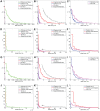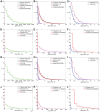Comparison of models for IP3 receptor kinetics using stochastic simulations
- PMID: 23630568
- PMCID: PMC3629942
- DOI: 10.1371/journal.pone.0059618
Comparison of models for IP3 receptor kinetics using stochastic simulations
Abstract
Inositol 1,4,5-trisphosphate receptor (IP3R) is a ubiquitous intracellular calcium (Ca(2+)) channel which has a major role in controlling Ca(2+) levels in neurons. A variety of computational models have been developed to describe the kinetic function of IP3R under different conditions. In the field of computational neuroscience, it is of great interest to apply the existing models of IP3R when modeling local Ca(2+) transients in dendrites or overall Ca(2+) dynamics in large neuronal models. The goal of this study was to evaluate existing IP3R models, based on electrophysiological data. This was done in order to be able to suggest suitable models for neuronal modeling. Altogether four models (Othmer and Tang, 1993; Dawson et al., 2003; Fraiman and Dawson, 2004; Doi et al., 2005) were selected for a more detailed comparison. The selection was based on the computational efficiency of the models and the type of experimental data that was used in developing the model. The kinetics of all four models were simulated by stochastic means, using the simulation software STEPS, which implements the Gillespie stochastic simulation algorithm. The results show major differences in the statistical properties of model functionality. Of the four compared models, the one by Fraiman and Dawson (2004) proved most satisfactory in producing the specific features of experimental findings reported in literature. To our knowledge, the present study is the first detailed evaluation of IP3R models using stochastic simulation methods, thus providing an important setting for constructing a new, realistic model of IP3R channel kinetics for compartmental modeling of neuronal functions. We conclude that the kinetics of IP3R with different concentrations of Ca(2+) and IP3 should be more carefully addressed when new models for IP3R are developed.
Conflict of interest statement
Figures




 M, [IP3] = 2
M, [IP3] = 2  M and Sim 2 [Ca2+] = 0.2
M and Sim 2 [Ca2+] = 0.2  M, [IP3] = 10
M, [IP3] = 10  M (as shown in Table 6).
M (as shown in Table 6).
 M, [IP3] = 2
M, [IP3] = 2  M and Sim 4 [Ca2+] = 0.1
M and Sim 4 [Ca2+] = 0.1  M, [IP3] = 10
M, [IP3] = 10  M (as shown in Table 6).
M (as shown in Table 6).
 M, [IP3] = 2
M, [IP3] = 2  M and Sim 6 [Ca2+] = 0.01
M and Sim 6 [Ca2+] = 0.01  M, [IP3] = 10
M, [IP3] = 10  M (as shown in Table 6).
M (as shown in Table 6).Similar articles
-
Analyzing and Quantifying the Gain-of-Function Enhancement of IP3 Receptor Gating by Familial Alzheimer's Disease-Causing Mutants in Presenilins.PLoS Comput Biol. 2015 Oct 6;11(10):e1004529. doi: 10.1371/journal.pcbi.1004529. eCollection 2015 Oct. PLoS Comput Biol. 2015. PMID: 26439382 Free PMC article.
-
A kinetic Monte Carlo simulation study of inositol 1,4,5-trisphosphate receptor (IP3R) calcium release channel.Comput Biol Chem. 2007 Apr;31(2):99-109. doi: 10.1016/j.compbiolchem.2007.02.009. Epub 2007 Feb 20. Comput Biol Chem. 2007. PMID: 17392027
-
A kinetic model of single and clustered IP3 receptors in the absence of Ca2+ feedback.Biophys J. 2007 Aug 15;93(4):1151-62. doi: 10.1529/biophysj.107.108795. Epub 2007 May 25. Biophys J. 2007. PMID: 17526578 Free PMC article.
-
IP3 Receptor Plasticity Underlying Diverse Functions.Annu Rev Physiol. 2020 Feb 10;82:151-176. doi: 10.1146/annurev-physiol-021119-034433. Epub 2019 Nov 15. Annu Rev Physiol. 2020. PMID: 31730387 Review.
-
Inositol 1,4,5-trisphosphate receptor-isoform diversity in cell death and survival.Biochim Biophys Acta. 2014 Oct;1843(10):2164-83. doi: 10.1016/j.bbamcr.2014.03.007. Epub 2014 Mar 15. Biochim Biophys Acta. 2014. PMID: 24642269 Review.
Cited by
-
Simulation of calcium signaling in fine astrocytic processes: Effect of spatial properties on spontaneous activity.PLoS Comput Biol. 2019 Aug 19;15(8):e1006795. doi: 10.1371/journal.pcbi.1006795. eCollection 2019 Aug. PLoS Comput Biol. 2019. PMID: 31425510 Free PMC article.
-
Inositol 1,4,5-trisphosphate receptors in the endoplasmic reticulum: A single-channel point of view.Cell Calcium. 2015 Jul;58(1):67-78. doi: 10.1016/j.ceca.2014.12.008. Epub 2014 Dec 18. Cell Calcium. 2015. PMID: 25555684 Free PMC article. Review.
-
Biological physics to uncover cell signaling.Biophys Rev. 2025 Apr 10;17(2):271-283. doi: 10.1007/s12551-025-01308-8. eCollection 2025 Apr. Biophys Rev. 2025. PMID: 40376425 Review.
-
Reproducibility and Comparability of Computational Models for Astrocyte Calcium Excitability.Front Neuroinform. 2017 Feb 21;11:11. doi: 10.3389/fninf.2017.00011. eCollection 2017. Front Neuroinform. 2017. PMID: 28270761 Free PMC article.
References
-
- Libersat F, Duch C (2004) Mechanisms of dendritic maturation. Mol Neurobiol 29: 303–320. - PubMed
-
- Michaelsen K, Lohmann C (2010) Calcium dynamics at developing synapses: mechanisms and functions. Eur J Neurosci 32: 218–223. - PubMed
-
- Banerjee S, Hasan G (2005) The InsP3 receptor: its role in neuronal physiology and neurodegeneration. Bioessays 27: 1035–1047. - PubMed
-
- Bliss T, Collingridge G (1993) A synaptic model of memory: long-term potentiation in the hippocampus. Nature 361: 31–39. - PubMed
Publication types
MeSH terms
Substances
LinkOut - more resources
Full Text Sources
Other Literature Sources
Molecular Biology Databases
Miscellaneous

